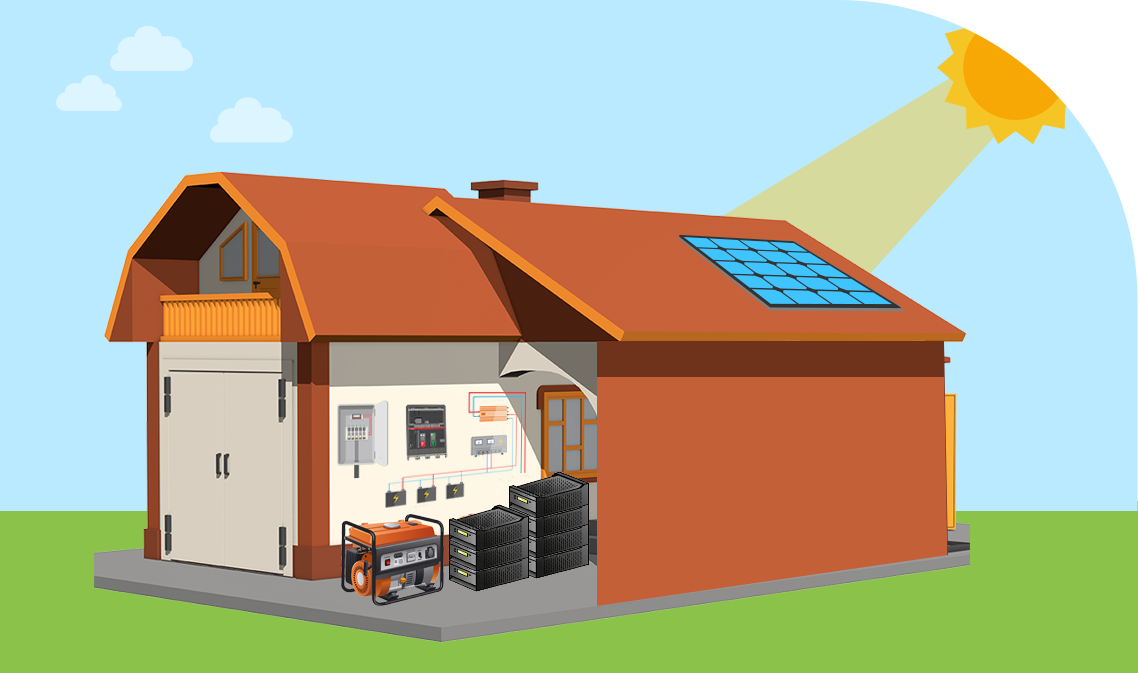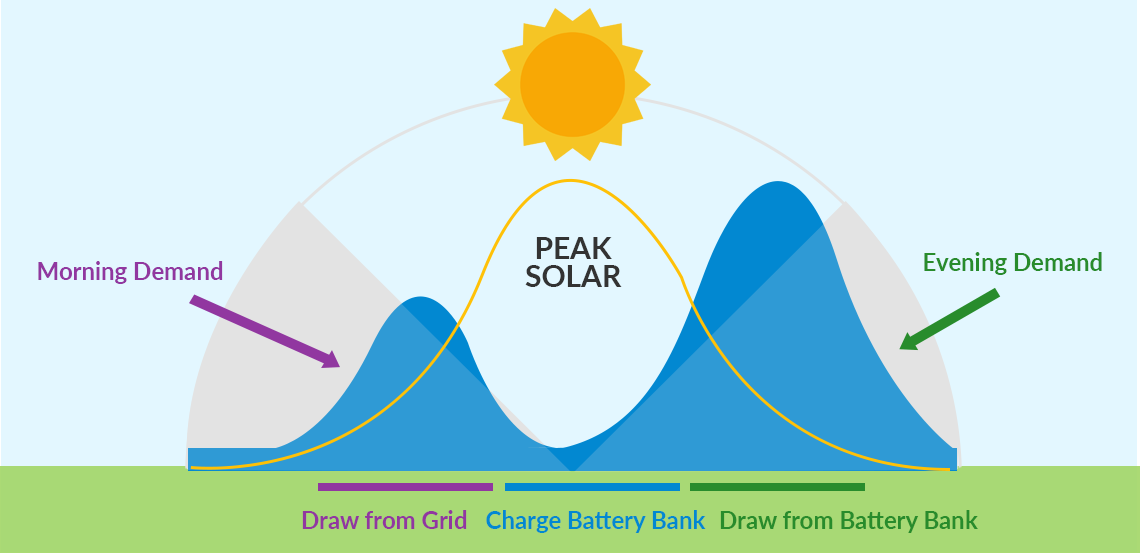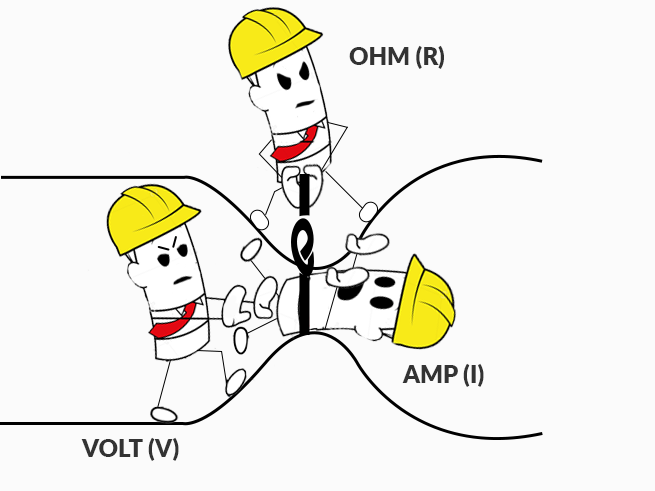A solar battery is simply a battery charged with energy from solar panels. There are lots of types – tiny to utility-scale. If you’re looking for smaller solar power solutions, check out our pages on:
But if you’re interested in solar batteries to power your home, read on …
You hear it everywhere: Battery storage is the next big thing in renewable energy. Solar was disruptive for the utilities; now batteries and inverters that can let homeowners avoid peak, high-cost energy costs or cut the utility cord completely are in position to be the next disruptive technology. This guide is going to help you decide if you need a solar battery system to accompany your solar array and if you do, what type.
Is a Solar Battery Bank Right for Your Home?
For most residential solar PV system owners, a battery bank will not be necessary. That’s because most systems are tied into the local utility, which provides consistent service with few power outages. To put it another way, the local utility, in effect, works as the solar PV system’s battery storage system, taking in excess electricity from the homeowner’s system when it’s producing more energy than the home is consuming, and providing electricity to the home when more energy is being consumed than the panels are generating.
However, not everyone has access to a public utility or is lucky enough to live in an area free of frequent power outages. Additionally, a small but determined number of consumers prefer to remain off-the-grid even when tie-in to a local utility is available. Here’s a closer look at some of the most common reasons to opt for a battery bank for a residential solar PV system:
For those adventurous types without access to a public utility and in need of a reliable and continuous electricity source for their off-the-grid home, battery backup is essential. Most people should plan on installing a battery bank that can supply electricity for several days of PV panel generation inactivity.


When 100 percent self-sufficiency isn’t the goal, a battery bank is still a great way to significantly decrease total dependence on the grid for your PV system’s backup. Many homeowners want the security of knowing they can supply a day or two of electricity without relying on generation from their panels or their local utility.
When power supply consistency and dependability are of the utmost importance, a battery bank is a great option. Simply put, some places are prone to power outages more than others. Frequent power outages are the result of any number of causes including an increase in extreme weather events, greater energy demands from the public and an ever-aging infrastructure.


People consuming energy from their local utility during “peak times,” usually between 4 p.m. and 10 p.m., pay higher rates for that energy usage than when consuming energy during non-peak hours. A consumer with a battery bank can feed off of their batteries during those peak times and avoid paying the higher utility rates.
Residential solar PV systems come with big upfront costs that consumers intend to pay off over time by avoiding high utility rates and, in some cases, receiving payment for electricity generated by the PV system and placed into the utility’s grid. But what if the utility rules or rates change? A battery backup can help protect that upfront investment when the payoff rules and rates change to the homeowner’s disadvantage.

Customers need to consider what their goals are and what their desired outcome is. Are you doing it because you are truly off-grid with no other power source and need to get through those cloudy days? Are you doing it because you want to have a backup while still using all your appliances? Are you doing it just to offset some costs on your electric bill?”
Grid-tie vs. Off-grid Solar Battery Systems
| Grid-tie | Off-grid | |
|---|---|---|
| Battery Bank Size | Optional, and often scaled to power only those devices designated as “essential” by the owner (lights, computers, refrigerator, freezer, etc.) Sizes vary. | Required to access energy when solar panels are not generating enough electricity to power household. Size varies according to owner’s needs and preferences. |
| Back-up Generator | Most, but not all, grid-tie systems have no backup generator. Utility produced power, in practice, acts as a backup when solar panels are not generating electricity. | Optional, but often incorporated into off-grid solar PV systems. Used when solar panels are not generating power and battery backup is depleted or not functioning. |
| Inverter | Dual-function inverter allows excess generated power to be supplied to utility grid while keeping energy flowing from the panels and/or (optional) battery bank when utility grid is down. | Stand-alone inverter converts DC from panels into AC for use in the household. |
Major Types of Solar Batteries
| Flooded Lead-Acid | Gelled Electrolyte Sealed Lead-Acid | Sealed Absorbed Glass Mat Lead-Acid (AGM) | Lithium-ion | Flow | |
|---|---|---|---|---|---|
| Description and optimal use | “Wet cell” battery filled with electrolyte. Optimal for medium to high-capacity off-grid use. | Sealed lead-acid battery that uses silica gel in which electrolyte is suspended. Optimal for most deep cycle applications. | Sealed lead-acid battery in which the electrolyte is held in thin glass mats instead of freely flooding the plates. Best suited for standby applications with infrequent deep discharges, but technology is improving for DoD uses. | The most common energy storage technology for all uses overall today. Lithium iron phosphate (LFP) batteries can be used for solar energy storage. | Consists of reaction stacks separated by electrolytes held in storage tanks. Optimal for storing large amounts of power. |
| Size | Not unlike auto batteries in size, but a full bank of batteries can be space-consuming. | Varies by capacity, but not unlike a marine or auto battery. Home bank will consist of several batteries. | Similar to flooded lead-acid and gel cell batteries. | Smaller and lighter than lead-acid batteries due to higher storage capacity. Home battery system typically the size of one or two washing machines or small refrigerators. | Varies. Can be very large. |
| Charging time | Varies greatly due to many factors. May take several hours to a day, or longer, for 100% charge. | A few to several hours depending on a variety of factors. | Up to five times faster than flooded battery technology. | Varies substantially dependent on several factors. Expect three hours or longer to fully charge. | “Recharges” by replacing the electrolyte, similar to filling an auto gas tank. |
| Lifespan | Depends on many factors including cycling. Well-maintained flooded lead-acid batteries can last up to 15 years or more, but four to eight years is more likely. | Eight years if properly maintained and DoD of less than 20%. In most cases, expect a battery life of two to five years. | Eight years if properly maintained and DoD of less than 20%. A good estimation is four to seven years. | High-quality battery can last up to 10 years. | Long lifespan. 25 years or more for vanadium redox batteries. Can be charged and discharged without lifespan impact. |
| Cycling | Depends heavily on depth of discharge (DoD) over the course of the battery life. Expect 200 to 300 discharge/charge cycles. | Varies significantly by capacity withdrawn. 1100 cycles at 50% withdrawn capacity. | Varies significantly by capacity withdrawn. Expect approximately 700 to 800 cycles under normal use. | Varies significantly by several factors including capacity withdrawn. 5,000 to 7,000 cycles possible for quality battery. | No cycling limitations. |
| Maintenance | Requires regular maintenance including adding water, cleaning terminals and venting. | Maintenance-free. | Maintenance-free. | Maintenance-free. Solid, no water filling or refilling required. | Low maintenance. |
| Temperature sensitivity | Yes. Lower temperatures reduce battery capacity. Higher temperatures increase capacity, but degrade battery life for all types of lead-acid batteries. | Yes. Lower temperatures reduce battery capacity. Higher temperatures increase capacity, but degrade battery life for all types of lead-acid batteries. | Yes. Lower temperatures reduce battery capacity. Higher temperatures increase capacity, but degrade battery life for all types of lead-acid batteries. | Yes. Higher temperatures can cause performance degradation. | Yes. |
| Safety | Contains toxic and corrosive lead and sulfuric acid. Caution must be taken when refilling and recharging. Gaseous hydrogen may cause explosion. | Contains toxic and corrosive lead and sulfuric acid. Gaseous hydrogen may cause explosion. Caution must be taken when recharging. | Contains toxic and corrosive lead and sulfuric acid. Gaseous hydrogen may cause explosion. Caution must be taken when recharging. | Despite reports of fires and explosions in the media, lithium-ion batteries are relatively safe when used properly. | Inherently safe. Electrolyte can’t get hot or catch fire. |
| Cost | Cheapest upfront cost of all types for solar PV applications. | Slightly more expensive than a similar capacity AGM battery. | Significantly lower upfront cost than lithium-ion and cheaper than gel cell, but more expensive than flooded lead-acid batteries. | Expensive, often twice that of lead-acid batteries. High upfront costs offset by long-term cost-effectiveness. | Expensive, although advances in organic aqueous technology may lead to substantially lower costs going forward. |
| Green factor | Low. Lead-acid batteries are toxic and flooded lead cell types can leak. | Low. Lead-acid batteries are toxic, although components may be recycled. | Low. Lead-acid batteries are toxic, although components may be recycled. | Depends. Some use organic materials that are toxin-free. Inorganic lithium-ion, however, is toxic and must be carefully disposed of. | Good. Long life cycle, high availability of required resources and good recycling ability. |
We are big believers that if you can stomach the upfront cost, there is no question lithium-ion batteries would be a better part of your solar home power system than using the lead-acid batteries that are available. The big trade-off is having a more costly piece of equipment, but one that lasts significantly longer and performs significantly better.”
Battery Configurations: Unlimited Possibilities
Determining the proper type and size of a solar PV battery bank depends on a lot of factors unique to a particular household’s needs and preferences. Here are some possible configurations for battery bank size, given a number of assumptions*:
| Watt-hours per day | Watt-hours per day plus 25% (for inefficiencies) | System Voltage | Battery Type | Individual battery voltage | Individual battery Ah capacity (@ 20-hour rate) | Number of batteries in series | Number of strings in parallel | Total number of batteries | Total system Ah capacity (@ 20-hour rate) |
|---|---|---|---|---|---|---|---|---|---|
| 1700 | 2125 | 12 | Flooded/wet lead-acid. | 2 | 1110 | 6 | 1 | 6 | 1110 |
| 2400 | 3000 | 24 | Absorbent Glass Mat (AGM) | 6 | 310 | 4 | 3 | 12 | 930 |
| 3000 | 3750 | 24 | Flooded/wet lead-acid. | 2 | 1110 | 12 | 1 | 12 | 1110 |
| 3600 | 4500 | 48 | Gel | 6 | 189 | 8 | 3 | 24 | 567 |
| 4200 | 5250 | 48 | Absorbent Glass Mat (AGM) | 12 | 370 | 4 | 2 | 8 | 740 |
* Examples assume: 3 days autonomy; 50% depth of discharge; 50 degrees bank temperature.
Battery Banks: Things to Think About
-
Watt hours required per day
This number is the sum of your daily power needs for all of your appliances and other loads, big and small.
-
Battery bank voltage
In order to charge a battery, a generating device must apply a higher voltage (the force of an electrical current) than exists in the battery or battery bank. For residential solar PV, the voltage is typically 12, 24, or 48.
-
Days without sun (days of autonomy)
To figure the amount of energy needed to be stored in a battery bank, it is important to know how many days that stored energy can be relied upon to satisfy the consumer’s particular needs.
-
Discharge
Depth of discharge (DoD) refers to the level a battery is discharged before recharging. DoD has a significant effect on battery efficiency and lifespan. In most cases, particularly with lead-acid batteries, a DoD of 50 percent is a good starting estimate. DoD for other battery types may vary considerably.
-
Temperature
Cold has a negative effect on battery performance. Temperature must be considered when sizing up the battery bank if the bank is located in a cold, or particularly hot, location. The colder the temperature, the larger the battery capacity needed. Notably hot locations will affect battery lifespan.
Declining Cost of Solar and Batteries
The two biggest reasons for the tremendous growth in solar PV systems in the U.S. over the last several years are the highly popular tax credits and incentives, and the plummeting prices for system components. Drops in the prices of batteries have also proved beneficial. Take the tremendous advances in technology and add in the huge increases in battery use. The result? Substantially lower battery costs that are expected to continue into the future, as shown in the two charts below:

Source: Bloomberg Business

Source: Solar Power World
How Solar Battery Storage Works

Solar photovoltaic (PV) panels take in sunlight and convert it into direct current (DC) electricity.
The critical load panel is an additional breaker panel through which the homeowner can designate those appliances and other loads to receive power during an outage.
The inverter “inverts” the DC current from the solar panels into usable AC current. The charge controller regulates the current to keep the batteries from overcharging. The system meter keeps track of the whole PV/battery system.
The battery bank is the system of batteries that stores energy generated from the solar panels or other sources to be used a later time.
The main disconnect, or disconnect switch, allows the user to turn off (disconnect) the solar PV system in case of maintenance, emergency or other safety-related issue.
A backup generator can be used to provide power during periods when the solar/battery system cannot generate enough power typically because of bad weather, power outage or high household demand.
One of the best ways to put a solar PV system with battery backup to good use is to charge up the batteries during peak photovoltaic times and then use the stored electricity when the sun is down. The result is less dependence on power provided by the local utility and the monthly bill that comes with it, as detailed in the graphics below:

Understanding Solar Battery Specs
People need to be smart consumers when it comes to understanding battery ratings – how they are advertised and how they are specified. Each company or product that you look at, make sure you understand what those ratings mean. You know, what does that 100 amp-hour label actually mean and how many amp-hours you can use before you have to charge [those batteries] up again?”
Don’t be embarrassed if you can’t understand the specifications that battery manufacturers provide with their products. You are certainly not alone. On their face, spec sheets can appear as a mystifying array of abbreviations, numbers and symbols that seem to require a college engineering degree to figure out. The result is that it’s often next to impossible to know if the specifications you are reading offer any useful information whatsoever. Here’s a look at five common items likely to appear on a battery spec sheet and what they mean:
Classification, or cell classification, refers to the battery type, i.e. flooded lead-acid, VRLA gel, glass mat (AGM), lithium-ion, etc.
Nominal voltage refers to the average voltage that a battery cell outputs when discharged. Real voltage is normally lower or higher, but remains near the nominal voltage for design and standards purposes.
The most common battery rating specification, capacity is normally stated in terms of amp-hours (Ah), which refers to the amount of energy that can be stored in a battery. The Ah rating is calculated by multiplying a current flow (amps) by the time (in hours) of discharge.
A spec sheet may have a listing that looks like this: “135 Ah @ 100 hours”, which means that the battery will provide 1.35 amps of current at a usable voltage continuously for 100 hours. The 1.35 figure is calculated by dividing the amp-hours rating (135 in this case) by the number of hours (100). Or you might see the listing take this form: “C/20 – 55Ah”. In this case, the battery will provide 2.75 amps for 20 hours.
Unfortunately, the amp-hour rating provides only a generalized way of understanding capacity, and has little meaning unless qualified by the depth of discharge.
A cycle refers to one complete discharge/charge of the energy in the battery. It is typically indicated in terms of battery’s “cycle life”, or total number of cycles in the practical use of the battery over time. Cycle life is often shown on a spec sheet as a graph or bar chart with “total cycles” on one axis and “depth of discharge” on the other axis. That’s because, as discussed earlier, the life of a battery is greatly affected by the level of discharge of each cycle.
Battery performance is almost always affected by its storage temperature: the higher the temperature, the higher its capacity or performance. Spec sheets may list an operating temperature range or offer a temperature/capacity percentage graph.
Watts vs. Amps vs. Volts: What’s the difference?

Ohms refer to the electrical resistance. The higher the ohms, the harder it is for electrical current to flow.
Voltage refers to the potential of energy movement. A volt is a unit measurement of the amount of force with which electricity is “pushed” between two points along a conductor. Think of voltage like the water pressure in a garden hose. The water pressure can remain in the hose whether it is coming out one end or not.
A watt is the standard unit of measurement of electrical power or, in other words, the unit measurement of the amount of work that can be completed. One watt equals one amp of current flowing at one volt.
Amps refer to the actual amount of energy passing through a conductor and pulled out for use. If a volt is like the water pressure in a garden hose, an amp is the water itself.
The relationship between watts, volts and amps works like this:
- Watts = Volts x Ampsor
- Volts = Amps/Wattsor
- Amps = Watts/Volts
Solar Battery FAQs
Of course. That is, if you install enough solar panels to generate the energy you need to run your household, and install enough battery backup to store the energy you need to run your household when the panels are not producing. It’s all about a consumer’s unique power needs, preferences and intentions.
In practical terms, nothing involving electricity is entirely safe. Nevertheless, battery storage of energy is safe if done properly. Issues to be concerned with include: electrical wiring; chemical hazards that could lead to fire and/or explosions, as well as leaks of toxic or corrosive materials; and escape of noxious gasses. Again, proper installation and use of batteries is the key to battery safety.
Locating a battery bank is crucial and depends on the types of batteries being used. For example, some batteries produce gasses that must be properly vented to avoid becoming a fire hazard. Generally speaking, a well-ventilated enclosure specifically designated for the battery bank should be used. It should be readily accessible to adults, but inaccessible to children, pets and pests. Remember to include signage with safety warnings and that also lists shutdown procedures.
The simple answer is yes. However, moving your battery bank requires proper removal, transport and reinstallation. Remember, moving a battery bank should never be thought of as a DIY project. Always use a fully licensed and experienced electrician for the job.
The real question is: “Should I be adding batteries to an already installed and working battery bank?” And the answer is probably not. First of all, mixing batteries of different brands, sizes or specs will probably not work together and could lead to full system failure. And mixing old and new batteries, even if all specs are the same, can cause any number of hazards because the new batteries will reach their state of charge earlier than the old ones. You may be able to add batteries to your system if, and only if, the ones you are adding are of the same brand, type, specs and, most importantly, roughly the same age. Otherwise, forget it.
Disposal of old batteries is an important concern. Batteries should always be properly recycled, regardless of type. What’s important to note here is that, like moving a battery bank, battery recycling is not a DIY activity. Batteries must be completely disassembled and their components properly recycled individually. So always take your old batteries to a licensed professional recycler.
The Future of Solar Battery Storage
A “prosumer” is a person involved in the design and customizing of products to fit their own needs. In regard to energy, a prosumer can be someone who both consumes and produces energy (placing it back into the grid,) typically through the use of a rooftop solar PV system.
Modern solar PV has been around since the mid 1970s when the first amorphous silicon photovoltaic cells were fabricated. Solar technology, both in general and in regard to residential energy storage systems (RESS), has developed in leaps and bounds pretty much ever since. There are lots of potential leaps forward on the horizon as well, a fact that will make energy prosumers very excited. First of all, in RESS terms, explosive growth is expected over the course of the next decade, driven by huge increases in residential solar PV use and with involvement by lots of big companies like Tesla, and up-and-comers like Dragonfly Energy.
It’s not only about raw growth, however. There’s plenty for prosumers to look forward to in terms of innovation as well. According to Navigant Consulting’s recent report, advances in lithium-ion battery technology are expected to lead the way, accounting for the vast majority of the coming RESS capacity. Look for growing development and use of lithium iron phosphate batteries, for example. Advances in technology for lead-acid and flow batteries mean that they too will play an important role in residential energy storage going forward.


